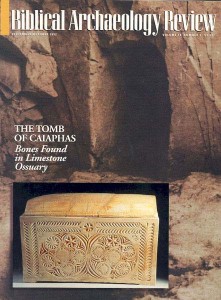Of all the people mentioned in the Bible—whether in major roles or in cameo appearances—only a handful other than rulers have been brought to historical light thanks to the archaeologist’s spade. Imagine, then, the excitement when workmen constructing a water park in Jerusalem’s Peace Forest stumbled across a burial cave containing 12 ossuaries, or bone boxes, including two bearing the name Caiaphas. One especially beautiful ossuary is twice inscribed “Joseph, son of Caiaphas” and holds, together with other remains, the bones of a 60-year-old male. This ossuary may well be the final resting place of the Caiaphas known from the New Testament as the high priest who conducted the initial interrogation of Jesus before handing him over to Pontius Pilate.

Because of the significance of this find and the great degree of interest in it, we are devoting two articles to the discovery. First Zvi Greenhut leads us into the “Burial Cave of the Caiaphas Family,” describing the cave and the dozen ossuaries contained within its four niches. Greenhut elaborates on the practice—widespread in the late Second Temple Period (first centuries B.C. and A.D.)—of placing the deceased within a burial chamber, allowing the flesh to decompose over time and then gathering the bones into an ossuary for final interment. Also of interest to readers will be Greenhut’s discussion of a coin found with one of the burials and its ramifications regarding pagan funeral practices in a Jewish tomb in Jerusalem.
Already a library member? Log in here.
Institution user? Log in with your IP address.

